It might only begin to sink in when you start playing, but the distinct possibility exists that WWE SmackDown! vs. RAW 2006 will be the last Yuke's-developed wrestler for the PlayStation 2. With the PlayStation 3 somewhere on the horizon and the PlayStation 2's life expectancy dwindling, it probably would have been easy for longtime wrestling game developer Yuke's to ease off the gas pedal when working on SmackDown! vs. RAW 2006. However, this latest and possibly last PS2 game in the series turns out to be much, much more than just a typical yearly update. Rather, SmackDown! vs. RAW 2006 cobbles together a veritable smorgasbord of new features and concepts for wrestling fans to smack their collective lips at. Without a doubt, this is the deepest that a SmackDown! game has ever been, and while not every single thing that this game tries works completely, the sheer breadth of content makes it an easy choice for any wrestling enthusiast, and quite possibly the best wrestling game available for the system.
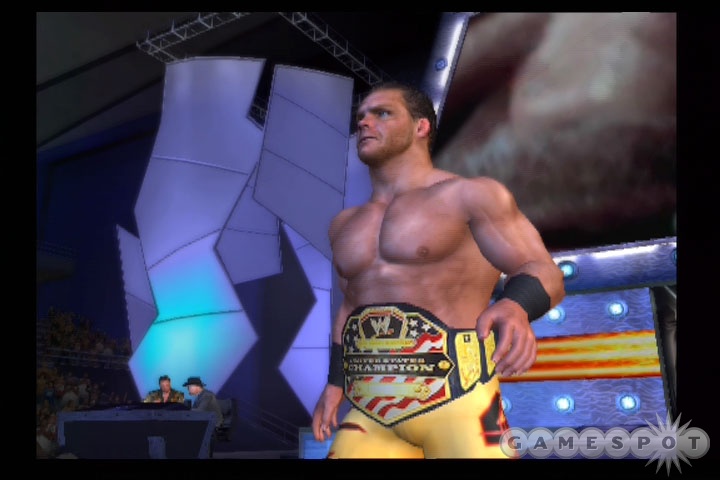
WWE SmackDown! vs. RAW 2006 is very much a Yuke's PlayStation 2 wrestling game. That is to say, if you played any of the developer's earlier games, this one isn't going to throw you for a loop. What it will do is show you a number of key refinements to the gameplay that help it emulate real-life wrestling (we use the term loosely, of course) better than any game before. For one thing, SmackDown! vs. RAW 2006 introduces a measure of ring psychology to the proceedings. Don't worry; you don't have to plan your spots or your finishes or anything. What's been introduced here is a pair of systems that track your wrestler's stamina, as well as his or her momentum, in the match. Stamina drains a number of ways, though mostly through pulling off and being on the butt end of big moves. Momentum is built by playing a more interesting match, one that will get the crowd thoroughly behind your wrestler.
The combination of these two systems leads to more logical and slightly more methodical matches. You can't get away with just pulling off lengthy strings of weak moves to survive, but you also can't just toss power move after power move at your opponent without draining your stamina. Therefore, you have to be smart, switching up between weaker and stronger moves, taking occasional breaks to regain stamina (which is done simply by holding down the select button) and playing to the crowd as much as you can. Both factors are visible throughout a match. When your wrestler's stamina is drained, he or she will double over in exhaustion. Likewise, if your momentum's low and the crowd isn't behind you, you might find yourself getting booed; you'll even hear chants of "Booo-ring!" from the audience. Your ability to pull off a finishing move is also directly tied in to the momentum meter. Building it up to its peak will let you pull one off or even store one for later--though finishers delivered at any momentum level other than the peak one won't do as much damage.
SmackDown! vs. RAW 2006 also manages to differentiate the unique styles (or lack thereof, in some cases) of the many WWE superstars. Whereas in the past, grappling attacks were relegated to the same four categories for every single wrestler, now each wrestler is assigned four of seven available categories. From within the game's move editor, you can assign them power, speed, technical, luchadore, brawler, martial arts, and old school categories. The one constant for all wrestlers is submission grapples, which is always assigned no matter what. But the remaining three categories can be divvied up however you like. There's also a fifth grapple category that determines what kind of wrestler you are, a heel or a face (in lay terms, a bad guy or a good guy). The moves are appropriately different, with the heel moves involving a lot of cheating and cheap shots, and the heroic moves staying well within the rules. Apart from the categorical changes though, this is very much the same type of grapple system the series has used over the last couple of games--so while things like trying to figure out who has what types of moves might take a bit of getting used to, fundamentally it should be familiar to you.
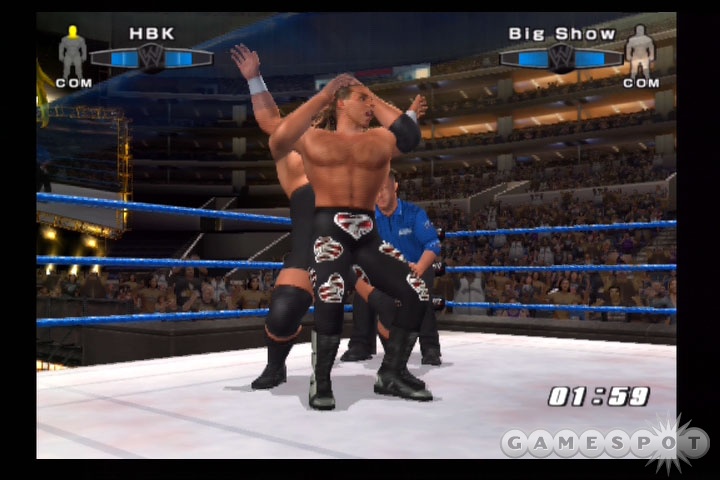
Believe it or not, the list of crazy additions to the gameplay engine does not end there. There are lots of little ancillary additions too, similar to some of the stuff Yuke's added last year, such as the prematch minigame. A couple of wrinkles have been tossed into the specials system. For instance, you can now steal an opponent's taunt by pressing the special button and hitting a taunt at the same time. Doing so completely drains your opponent's momentum. There's also an ability to play possum by countering a ground attack in combination with pressing the special attack button. This rolls your opponent up into a particularly sneaky pin.
SmackDown! vs. RAW even includes a deeper array of match types to keep you busy, on top of everything else. All the usual suspects are front and center once again, including cage matches, hell-in-a-cell matches, table matches, TLC matches, elimination chamber matches, first blood matches, and all the rest. New to the roster are fulfill-your-fantasy and buried alive matches. Fulfill your fantasy is the effective replacement to the always-lame yet always-included bra-and-panties matches, featuring exclusively the WWE divas. This one is equally silly, letting you choose outfits for the ladies to wear and asking you to pull off these goofy fantasy moves (most of which involve pillow fights, spanking, and other forms of titillation).
The buried alive match is an interesting addition; the whole strategy of the match is to drag your opponent out of the ring, down the aisle, and to a mound of dirt near the stage area, where a coffin is set up. Any wrestling fan worth his salt will know where this goes from here, and the mechanics of getting your opponent into that coffin and the lid shut aren't half bad (though somewhat frustrating at times). Ultimately, the buried alive match is a worthwhile addition, though the fulfill your fantasy match probably could have been bypassed altogether. But more interesting than these are the improvements to existing matches, like the cage match, for example, which now features an exit door and a much better method for emulating the struggle of climbing out of that cage. Ladder matches are better too, with multiple ladders available and a new brawling system that lets you duke it out with your opponent while both of you are on the ladder. Great stuff.
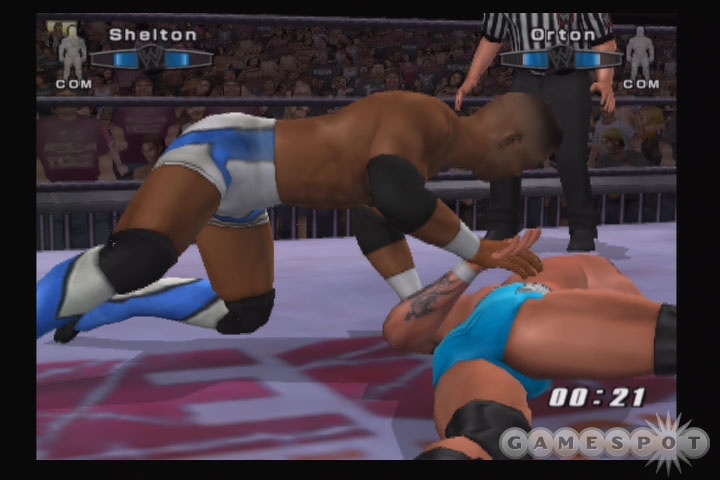
While all these fantastic additions might make SmackDown! vs. RAW 2006's gameplay sound like the most mind-blowing thing ever, it's ultimately what hasn't changed about the game that keeps it from perfection. For starters, the hit detection is still spotty. It's a far cry from the days when strikes would inexplicably miss and aerial moves would hit from bizarre distances, but it's still not quite right. You'll sometimes whiff on ground strikes while a guy is in transition between his getting-up animation and actually standing up, and it's not overly hard to miss a running strike if you don't have your opponent lined up just perfect. Aerial moves sometimes register oddly, too, missing at random times and, occasionally, hitting when it looks like you've missed. Again, the frequency of these hiccups is far less than it's been in the past, but when it happens, it definitely comes off as a problem.
The artificial intelligence of your opponents also has its flaws. There are four difficulty levels in the game, and the balance between them all is generally imperfect, with the easiest turning opposing wrestlers into brain-dead idiots who stand around for half a match without a clue of what to do, and the hardest turning the game into a festival of reversals that leaves you on the losing side far more often than not. The middle two levels are the most enjoyable, with the second-highest difficulty likely to be your eventual sweet spot once you master the game's mechanics. Still, on this level you'll run into a lot of reversals of your attacks. The fortunate thing is that it's easier this year for you to reverse attacks yourself, because the window for hitting a reversal button has been extended. It's not a guarantee, mind you, but you always feel like you at least have a decent shot of reversing attacks as much as your opponents do.
Of course, it wouldn't be much of a wrestling game if SmackDown! vs. RAW 2006 didn't offer up plenty of things to do other than just wrestling. As in past years, you'll likely spend much of your initial time with the game playing through the season mode. The season mode is a lot like last year's game, with a more structured storyline that doesn't involve many branching paths or choices, but features the voice talent of the WWE superstars. The good news is that unlike last year's game, the voice talent isn't completely horrible. The recording quality of the dialogue sounds right, and the vast majority of the wrestlers pull off their lines just as well as they would on TV. Sure, there are a few dead reads among the bunch, but this year they're in the vast minority. The writing is also really solid, with angles that play out as you'd expect a TV storyline to.
What's also cool about the season mode is that there are multiple unique storylines to play through. There's one for RAW superstars, one for SmackDown! superstars, and a third storyline that we only managed to get once, while playing as John Cena. So unlike in past years, there's good reason to go back and play through the season mode multiple times, other than just to earn more cash for unlockables. Another great thing is that every single wrestler in the game is voice acted, including the one you play as. You can use any wrestler from a specific show (save for a couple of omissions, like Eugene) as well as your created wrestlers (you can choose from five different voices in the create-a-wrestler mode), and the dialogue will change to match the wrestler you're playing with. Text menus be damned--this is the way to go. Sure, it would be nice if there were more branching paths that the story could take, but if it's between that and fully voice-acted storylines that are actually pretty good, then we'll take the latter.
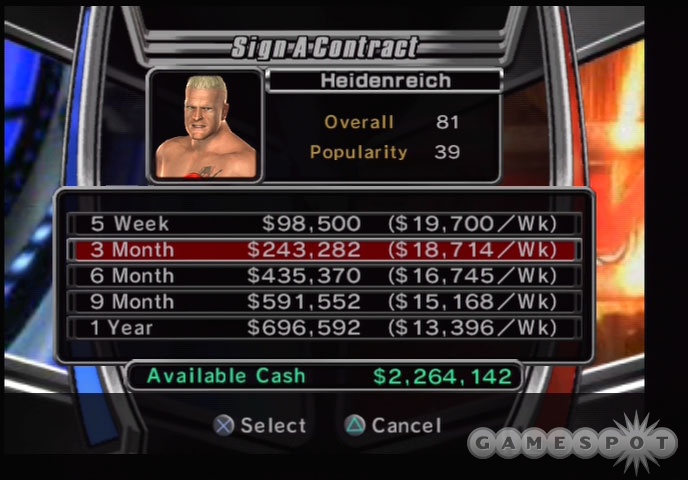
After you're done with the season mode, there's an all-new mode to play around with called the GM mode. Because general managers have played an increasingly key role in the way the WWE presents its storylines, it's not altogether surprising that a mode in which you yourself play that role would find its way into a wrestling game. The GM mode is basically the equivalent of a franchise mode in a sports game. You begin by drafting from the roster of available WWE superstars (or just sticking with whatever your chosen show's current roster is), and signing them each to contracts of varying length. You're working with a budget, so you can't just sign all the top guys to expensive long-term deals; so you'll find yourself trying to space out your deals as much as possible, and sometimes working with more rookies than perhaps you'd like.
The whole crux of the mode is that you're competing with the other WWE brand. You're judged by how many fans your show has, and whichever brand has the most fans at the end of the yearlong period in which the mode takes place is the winner. You earn fans by putting on good shows. Good shows have good matches. Good matches are measured by star ratings, awarded by the fans themselves. The fans like big names, and matches featuring wrestlers with higher popularity levels naturally get higher ratings. It also helps when the wrestlers involved in a match have an ongoing feud. You can check to see who has a feud going via a menu in the mode, and basically, to keep a feud going, you have to involve your wrestler in a match every week, or at least in a promo. Promos can be inserted for advertising purposes, resting popular wrestlers, building hype for pay-per-views and main events, and even raiding the opposing show.
All of this sounds great, but it's not all put together quite as well as it could have been. Again, this is a purely menu-based mode, so it can be tough to really get a handle on how well your shows are going. You certainly have the option to play through any of the matches you have on a card, but it's tough to gauge whether doing so actually has any bearing on the rating at the end. You also don't ever get to watch any promos happen, so they're purely transparent. Another problem is that it's exceedingly tough to build up rookie wrestlers to an acceptable popularity level. There's no farm system or B-grade show like Velocity to send them down to for seasoning purposes. So you'll have at least a few one-star matches on every card, simply because you have wrestlers that just can't get over with the crowd. Popularity seems to come from wins, but putting rookies in against popular wrestlers for the purposes of getting them some wins just takes too long, and ultimately this drops the popularity of your already-popular wrestlers.
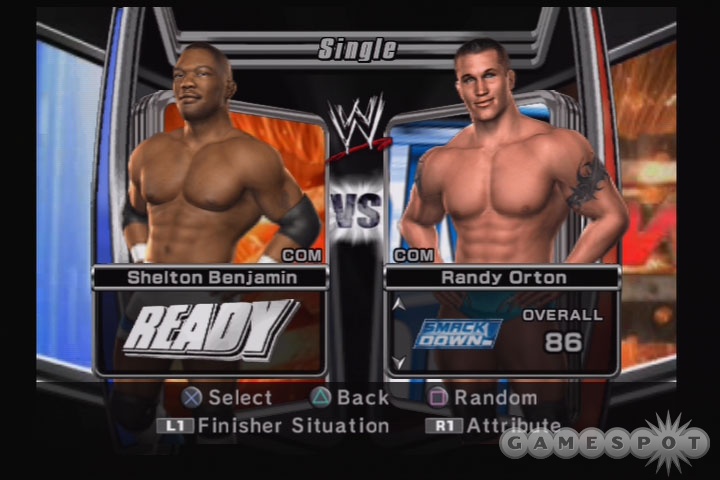
But even with all that said, the GM mode is a fun distraction, and it seems like it could be the groundwork for far more spectacular things in the future. The concept of being able to manage shows from the GM level and book your own cards is great. If that can be built upon, giving players more control over feuds and angles, making promos visible, and so on and so forth, that could be something really special. We'll just have to wait and see where Yuke's goes with this in the future.
Perhaps the biggest and simultaneously most disappointing part of last year's game was the debut of online play. Last year's online mode was barren, slightly laggy, and altogether dull. In this year's game, the online is a different animal. Up to four players can wrestle at once in a host of different match types, including practically every type of gimmick match, and even title matches. The titles you'll be vying for are the ones you create, and you can even make wagers with money you've won offline. On top of the match variety, there's also a feature that lets you trade created wrestlers between players. It's just a separate lobby section you can jump into, and it's pretty easy to do. Wins, losses, title defenses, and the like are tracked via the online scoreboards, too. Disappointingly, there's no real friends list to speak of, and the online community has already found obnoxious things to do to one another--things that the system probably could have prevented with a little more forethought. The game does track the number of disconnections an opponent might have, so you can at least try to avoid irritating players that way. Also, the online performance can vary wildly depending on connection speed. We had matches that were badly bogged down with lag, where actions were well behind button presses, and others that were practically lag-free. Just be aware that your mileage may vary.
There's also the usual array of creation modes to play with. The create-a-wrestler is pretty much as good as it's ever been, as is the create-a-belt mode from last year. The one major addition to the pack is the create-an-entrance mode, letting you specifically design the crazy pyrotechnics and camera angles that come with a superstar's entrance. It's the same concept that the Day of Reckoning franchise has used on the GameCube over the last couple of years, though it's not as good. There's no easy way to see exactly where each labeled camera angle is set up, nor what each pyro type looks like, so you'll have to go through each and every one, viewing the complete entrance preview each time, which can be time consuming. This is one case in which Yuke's probably would have been better served just making a carbon copy of what they'd already created, rather than trying to toss something new in.
Graphically, SmackDown! vs. RAW 2006 features easily the most refined and attractive-looking character models ever put into a wrestling game. The detail in each and every character is phenomenal. Facial animations look realistic, skins and costumes are supremely detailed, and the various cutscenes presented throughout the game, be they during the season mode or simply a quick cut of a particularly devastating move during a match, are wonderful. Amazingly enough, the frame rate holds up extremely well, even during matches with the maximum number of wrestlers in the ring, and the only time you might notice a bit of slowdown is during some entrance sequences with particularly elaborate pyrotechnics. Even the created wrestlers look just about on par with the models that Yuke's itself designed, making their inclusion in a match all the more seamless. Were it not for the collision issues, this would be graphical perfection for a wrestling game on the PS2.
The audio is also much improved from last year. Apart from the mostly great voice acting, commentary is better this year. Both the teams of Jim Ross and Jerry Lawler and Michael Cole and Tazz are on hand for their respective shows, and while the lines of commentary are mostly innocuous and don't get into much depth within the matches themselves, the lines are somewhat less repetitive than they've been in previous years. The season mode also makes good use of the commentators during cutscenes to set the stage for the storyline. More licensed music is on hand for soundtrack purposes, though it's a weird list of artists, ranging from the Dillinger Escape Plan to Bumpy Knuckles. There's even a remix of Megadeth's "Symphony of Destruction" for some reason. Sadly, none of John Cena's album is used for the soundtrack for some reason.
Not every single thing that WWE SmackDown! vs. RAW 2006 tries to do completely works, but the sheer amount of crazy new stuff in this game more than makes it worth the while of any wrestling fan. The gameplay is the best it's ever been, the presentation is top-notch, and the plethora of available modes is more than enough to keep any WWE enthusiast busy for hours and hours. Maybe Yuke's will surprise everyone and put together another SmackDown! vs. RAW game for the PlayStation 2 next year; but if this does turn out to be the last one for the system, then it will have gone out with a bang.
